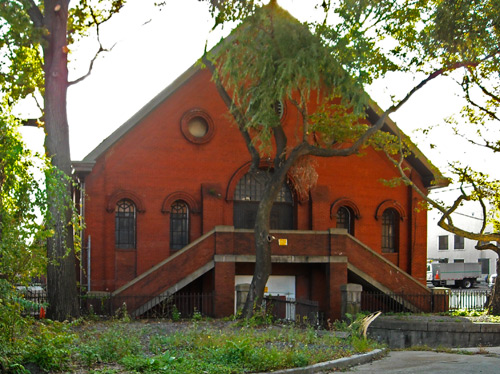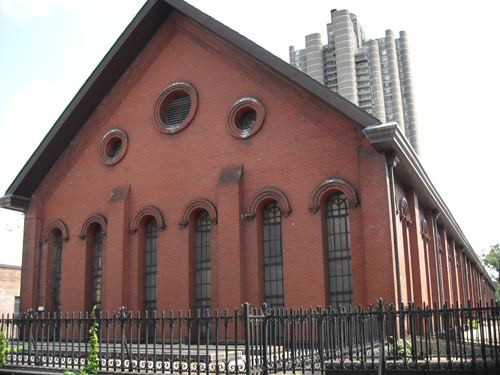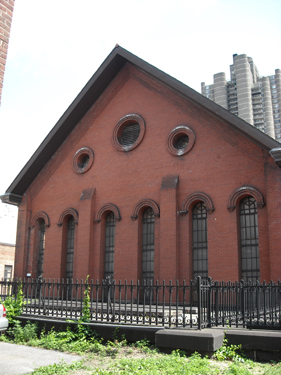High Pumping Station

Jerome Avenue near Mosholu Parkway South
John Wheeler, builder
1901-06
The foundation of this “high service” pumping station, whose purpose was to increase water pressure for tall buildings, were laid in 1901, near the rim of the Jerome Park Reservoir’s planned East Basin. But although excavated, that half of the distributing reservoir was never built. In 1911 the unused land was turned over to the city for other uses—among them, a train yard for the IRT subway, and eventually, the sites for DeWitt Clinton High School and The Bronx High School of Science. All these now intervene between the pumping station and the West Basin, which supplies it with water through underground pipes.
The red brick building, completed in 1906, houses a row of pumps at ground level. Originally, a thin, tall, square-plan brick water-tower rose abruptly at the mid-point, without any architectural attempt being made to soften the perpendicular. In contrast, the surviving building on Jerome Avenue is emphatically low and long. No fewer than forty-two identical two-storey, round-headed windows march down the façade. Thick flat buttresses divide the wall into bays, with a pair of windows in all but two of them. There is no projection or elaboration to distinguish the sixth and twelfth bays, where arched doorways replace the windows. A pitched roof stretches unbroken from gable-end to gable-end, deep eaves extending the lateral movement.
Geometry and repetition announce the industrial mission of the pumping station, but its pared-down Romanesque Revival architecture makes room for expression in fine details of brickwork. Each of the windows, for instance, is crowned with an “eyebrow” or arched hood molding, its ends resting on delicate brick corbels. Under the overhanging gables are wide “eaves courses” of brick, stepped progressively outward to form a support. The three bulls-eye windows in each end are set in compound, circular brick frames.
The pump house’s neo-Romanesque style, which first appeared in America in the 1840s, must have seemed in 1906 a little old-fashioned for a public works project in the recently consolidated City of New York. A more dramatic interpretation of the Romanesque, using stonework, circular towers and low arches, had been popularized by H.H. Richardson and his followers in the 1870s. In fact, the residence built for the Reservoir Keeper, which once stood just to the north of the pumping station, had been an example of the Richardsonian, its stone-faced ashlar consistent with other structures on the New Croton water system, including those planned for the Jerome Park Reservoir. Among these, the red brick Pumping Station would have been an outstanding sore thumb.
The incongruity may have been intentional. There had been a long-standing political rivalry among those responsible for building the Jerome park facilities, between employees of the city’s Department of Water Supply and the state-appointed Aqueduct Commission. George Birdsall, the chief engineer who oversaw the design of the pump house, belonged to the Tammany-dominated DPW faction, which eventually triumphed in 1910, leaving many of the Commission’s grand stone projects—the gatehouses and East Basin among them—uncompleted. In its “stylistic and material differences from the architecture of the Aqueduct Commission,” writes historian Robert Kornfeld, the inglorious High Service Station “can be interpreted as defiant or hostile.”
David Bady
Photographs:
Lehman College Art Gallery and Abigail McQuade


